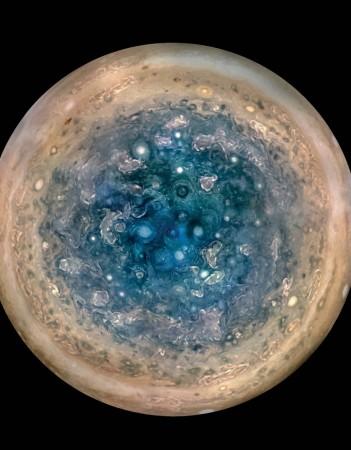
NASA's Juno mission has now revealed that Jupiter has Earth-sized polar cyclones and storm systems that travel deep into the heart of the gas giant. It also has a mammoth, lumpy magnetic field that may indicate that it was generated closer to the planet's surface than previously thought.
Also Read: CIA killed Marilyn Monroe to prevent her from exposing truth about Roswell UFO crash? [VIDEO]
"We are excited to share these early discoveries, which help us better understand what makes Jupiter so fascinating," said Diane Brown, Juno program executive at NASA Headquarters in Washington.
"It was a long trip to get to Jupiter, but these first results already demonstrate it was well worth the journey," Brown added.
The Juno spacecraft was launched in August 2011 and reached Jupiter's orbit in July 2016. The spacecraft flew at an altitude of around 4,200 kilometers (2,600 miles) on the cloud tops of the planet in August 2016 and the data collected have been published in two papers in the journal Science, as well as 44 papers in Geophysical Research Letters.
"We knew, going in, that Jupiter would throw us some curves," said Scott Bolton, Juno principal investigator from the Southwest Research Institute in San Antonio.
"But now that we are here we are finding that Jupiter can throw the heat, as well as knuckleballs and sliders. There is so much going on here that we didn't expect that we have had to take a step back and begin to rethink of this as a whole new Jupiter, Bolton stated further," Bolton added.

The photos taken by JunoCam show that both the poles of Jupiter are covered by storms which are Earth-sized and they are densely clustered and rubbing together.
"We're puzzled as to how they could be formed, how stable the configuration is, and why Jupiter's north pole doesn't look like the south pole," said Bolton. "We're questioning whether this is a dynamic system, and are we seeing just one stage, and over the next year, we're going to watch it disappear, or is this a stable configuration and these storms are circulating around one another?"
Another finding from Juno's Microwave Radiometer (MWR) -- which samples the thermal microwave -- reveals that the gas giant's iconic belts and zones are unexplained, and got the belt near the equator penetrating all the way down, while the belts and zones at other latitudes seem to evolve to other structures. The data suggest that ammonia is quite variable and continues to increase as far down as we can see with MWR, which is a few hundred miles or kilometers.
Jupiter was known to possess the most intense magnetic field in the solar system before the Juno mission. The scaling of the magnetosphere of the gas-giant with the help of Juno's magnetometer investigation (MAG) revealed that the planet's magnetic field is stronger than the models had expected and it's more irregular in shape.
The MAG data also reveals that the magnetic field had exceeded expectations at 7.766 Gauss, which is ten times stronger than the strongest magnetic field found on Earth.
"Juno is giving us a view of the magnetic field close to Jupiter that we've never had before," said Jack Connerney, Juno deputy principal investigator and the lead for the mission's magnetic field investigation at NASA's Goddard Space Flight Center in Greenbelt, Maryland.
"Already we see that the magnetic field looks lumpy: it is stronger in some places and weaker in others. This uneven distribution suggests that the field might be generated by dynamo action closer to the surface, above the layer of metallic hydrogen. Every flyby we execute gets us closer to determining where and how Jupiter's dynamo works," Connerney concluded.

















